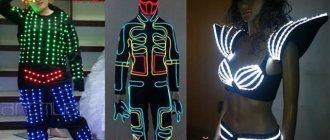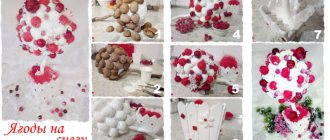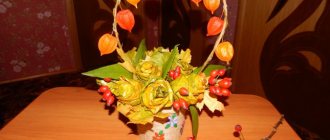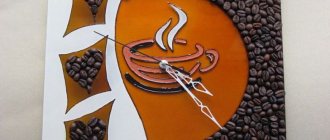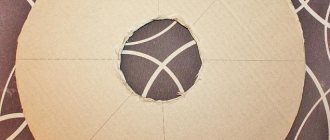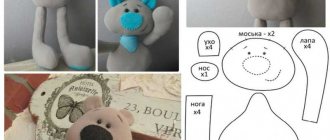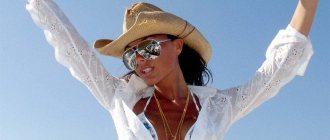If children need to be occupied for a long time and distracted from the TV or mobile gadgets, there is nothing better than an origami paper zoo. Animals are one of the most attractive subjects in images; they evoke positive emotions and encourage creativity. Also, by creating paper animals and birds, children remember information about natural prototypes much better. A ready-made origami zoo can easily be turned into a tabletop theater, acting out scenes with its inhabitants. Depending on the age of the child, you should choose models of varying complexity, but it is desirable that the figures are realistic.
Tiger
The largest representative of the cat family is in almost every zoo. It impresses with its power, size, graceful plasticity and characteristic colors. Interestingly, not only the predator’s fur is colored with stripes, but also its skin. If someone decides to shave a tiger's head, after a while the colored hairs will grow back in the same order. The stripes of each animal are individual; their pattern, according to scientists, is not repeated.
In addition, each individual has a specific tone of voice, by which predators recognize each other. When angry, tigers do not growl, but hiss like domestic cats. And they are also capable of purring if they are in a good mood. A tiger rarely attacks a person, and if it does, it tries to do it from behind. Therefore, in Indian zoos, keepers put a mask with a face on the back of their heads, deceiving the predator.
The paper tiger will not attack - it can be folded slowly, as carefully as possible.
You will need:
- 2 squares of orange or yellow paper 21x21 cm;
- scissors;
- glue stick;
- black marker.
The figurine is an origami of medium complexity. It is created based on the basic form “Bird”.
Step-by-step instruction:
- We divide the square with four main fold lines: diagonal and longitudinal-transverse. To do this, we consistently fold it in half and open it.
- We bring the extreme points to the center and press the lowering valves. It turns out to be a “Double Square”. We place its free end down and to the right.
- We bend the side corners of the layer closest to us towards the middle. Lower the top triangle. Open up the folds you just made. Raise the bottom point up until it stops, press the sides, aligning them along the vertical axis.
- Turn the figure over and repeat step 3 on the reverse side.
- Let's start making the head and front paws of the tiger. We place the “Bird” with the free ends facing us. Fold them up and to the sides. Make a fold in a different direction. Using a reverse fold, we bring the ends inward.
- We bend the figure in half vertically “mountain-wise”. We turn the workpiece so that the free ends, which will become tiger paws, are at the bottom. On the left side we make a reverse fold, but not inward, but outward - “valley”.
- We fold the upper part of the figure down, forming the head of a tiger. We bend the bottom point - we get a “chin”. We make small slits in the top layer at the “back of the head”. Raise the points up and out to form ears.
- From the second square we assemble the back. We start again with the basic “Bird” shape. We turn the model with the open ends towards us. We fold them according to the same algorithm as the front “legs”. We position the workpiece with the massive end to the left. And flip the top layer to the right. At this point, the tiger's tail begins to form.
- We fold the sides of the right side towards the center, slightly short of it. Smooth out the resulting folds well.
- Fold the leftmost point to the right so that it touches the opposite multilayer part of the model.
- We bend the workpiece in half “mountainwise” horizontally.
- We connect both halves of the animal by inserting the protruding parts of the front into the lower “pockets” of the back. It’s better not to stop there and glue them together additionally. Using reverse folds, we give a curved shape to the paws and tail.
We draw stripes and a face for the tiger to make it look more realistic.
Progress:
1. Bend each sheet of cardboard in half , with the colored side facing inward.
2. We draw silhouettes of animals on one side of the cardboard - on gray - a horse, on green - a crocodile, on yellow - a giraffe.
3. Cut out animal shapes along the contour of the picture.
4. Turn the cardboard color side up.
5. Use a stapler to attach the giraffe’s head to the body, apply circles, spots with a felt-tip pen or glue them onto the animal’s body.
6. Bend the crocodile’s paws, draw eyes or glue them, you can attach white teeth.
7. Bend the horse’s head blanks in half, cut small strips with scissors - the hair on the mane and tail.
«Zoo»
ready, you can play!
Master class “Smart cardboard. Assembled toys made of cardboard." SMART CARDBOARD “ASSEMBLED CARDBOARD TOYS” The master class is accompanied by a presentation. Designed for 8-10 participants. Each participant has.
Giraffe
After the largest land predator, it is worth moving on to the herbivorous giant. His life begins with a fall from a 2-meter height, as the mother gives birth to her babies while standing. Adult giraffes grow up to 6 m, with 1/3 of the total body length coming from the neck. Despite their two-ton weight, African giants run well, reaching speeds of up to 50 km/h. Although even with normal walking it is not easy to catch up with them, because with each step the animal covers a distance of 4 m.
Giraffes devote almost a full day - from 16 to 20 hours - to eating. Which is not surprising given such colossal dimensions. If males and females approach the same tree, they stand on different sides of it so as not to interfere with each other during “lunch.” This does not mean that giraffes are completely peaceful and never clash with each other. But relationships are sorted out mainly by males during the rutting period. They arrange a kind of arm wrestling, using their powerful, muscular necks instead of arms. But these herd animals do not fight for territory; moreover, they willingly accept strangers.
The river is an insurmountable obstacle for the tallest creatures in the world. Due to their thin legs and heavy weight, they cannot move on muddy soil. Having encountered a swamp or other body of water on the way, giraffes are forced to turn back.
Zoos are as rarely without the charming herbivorous giants as they are without tigers. Therefore, you must make them for your origami collection. Moreover, the model belongs to the category of simple ones.
Master class: cardboard twitch toy “Puss in Boots”
Materials and tools:
— sheets of A4 size office paper (for printing templates); — packaging micro-corrugated cardboard (1.5 mm thick) or cardboard for children's creativity; - a sheet of thick white A4 paper; - standard (stationery) knife; - scissors; - awl; — paracord (4 mm in diameter) or other fasteners; - nylon thread, narrow ribbon; - glue stick; — glue “Moment Crystal”; - double sided tape.
So, we start by preparing the cardboard parts for the base of the twitch toy.
We print outline templates on office paper. We cut them out with small allowances.
We glue pieces of double-sided tape on the wrong side and glue the templates to the wrong side of the cardboard.
In this case, micro-corrugated cardboard with a thickness of 1.5 mm is used. But I would like to immediately draw your attention : the contours of the parts here are quite curly, with small elements, so cutting out of micro-corrugated cardboard can be a little difficult if you are not used to it. And here you can go two ways:
1. neglect small elements and smooth out the contours when cutting;
2. use thin cardboard (for example, cardboard for children's creativity; for greater rigidity, you can make it in 2 layers); In this case, the toy will also be quite functional; below you will see an example of such a design of the twitch.
Next, use a regular stationery knife to cut out the parts of the base. Immediately make holes for fastening. I used a punch with a diameter of 4 mm. If a punch is not available, you can cut holes with a knife or awl.
The diameter of the holes may differ from the original depending on what fasteners you use.
On thick white paper (on the front side) we print colored puss in boots templates. Cut it out.
Alternatively, you can color the cat with pencils or felt-tip pens together with your child. A special set of templates is provided for this.
Using a glue stick, glue the colored parts onto the cardboard bases (on the front side of the cardboard).
We fold our paws in pairs (on top of each other). And with an awl we pierce small through holes on the upper edges, as shown in the photo. These holes will be used to control the paws.
To attach the paws, white paracord with a diameter of 4 mm is used here. Cut 4 small pieces (the length is such that you can tie 2 knots).
We tie a tight knot at one end and melt the tip with a lighter. We pass the cord through the holes of the body and paws.
The paws should be located under the body.
This is just one of many mounting options. For movable fastening, you can use, for example, brads, buttons, wire, etc. - whatever you like best. The main thing is to make sure that the limbs of the twitching toy rotate freely in the same plane!
Let's proceed to the most important stage - creating the paw control mechanism. In fact, everything here is extremely simple. It is necessary to tie the paws in pairs with nylon thread through small holes. When the thread is taut, the limbs should be in a downward position.
Now we tie a long thread (can be folded in half) or a thin cord to the horizontal threads, both the top and the bottom, as shown in the photo.
We tie knots on the paracord from the wrong side of the toy. We check whether the paws rotate freely enough. We melt the ends of the cord.
Cut out 2 circles with a diameter of 2.5 cm from cardboard. If you use micro-corrugated cardboard, make a slot in the middle on the wrong side of one circle and place the end of the thread there.
Glue both circles with Moment Crystal glue.
Alternatively, instead of cardboard circles, you can attach a large bead - for convenience and beauty.
Glue a cardboard circle with a diameter of 3.5 cm to the head from the wrong side onto a loop of narrow ribbon.
The cardboard twitch toy is ready!
This is such a cheerful and lively cat in boots. The kids will be delighted!
